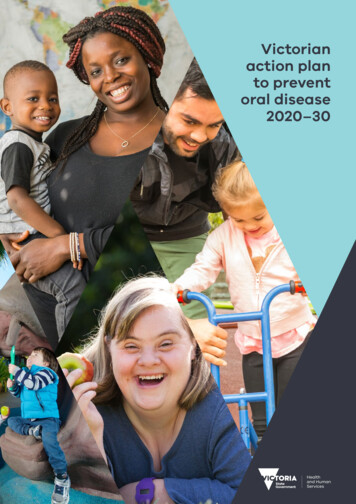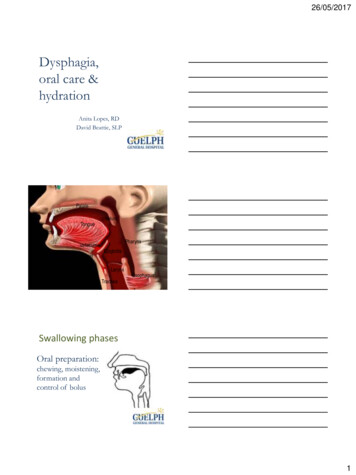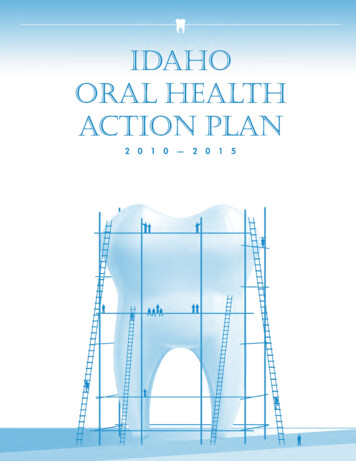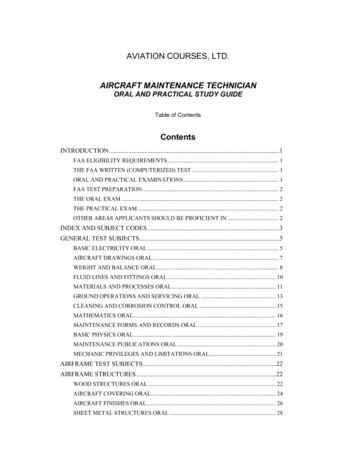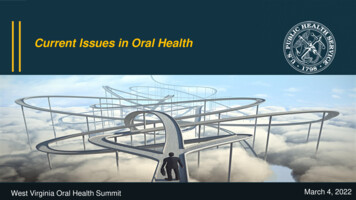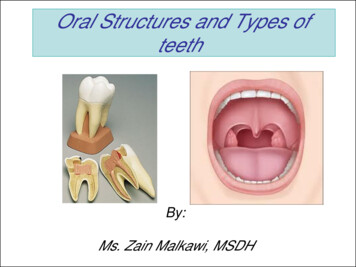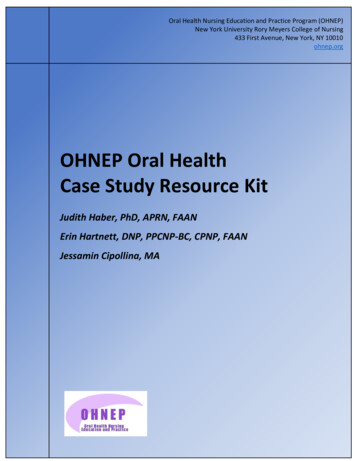
Transcription
Oral Health Nursing Education and Practice Program (OHNEP)New York University Rory Meyers College of Nursing433 First Avenue, New York, NY 10010ohnep.orgOHNEP Oral HealthCase Study Resource KitJudith Haber, PhD, APRN, FAANErin Hartnett, DNP, PPCNP-BC, CPNP, FAANJessamin Cipollina, MA
Clinical Oral Health Case Study Resource KitInterprofessional Oral Health Clinical Case StudiesThe mouth is the gateway to the rest of the body. Oral health care is essential to promoting positiveoverall health outcomes. The innovative clinical case studies in this kit demonstrate the many ways inwhich oral health and overall health are linked, as well as the role of intersectional collaboration acrossprofessions and settings in providing effective whole-person care that aim to improve health equity andhealth care equity. The case studies incorporate the social determinants of health in the clinicalexemplars of oral-systemic health in patients across the lifespan with health conditions includingdiabetes, COVID-19, heart disease, cancer, celiac disease and more.The case studies included in this kit are listed below. Click on the links to view and download from ourwebsite ohnep.org. Pediatric Case Studies: CS #1, CS #2NLN Accelerating Care Excellence for Pediatrics (ACE.P) Unfolding CaseAdolescent HPV: Promoting Vaccine Confidence Case StudyAdult Case Studies: CS #1, CS #2OrAll in the Family Lifespan Case StudyCOVID-19: Promoting Vaccine Confidence Case Studies: CS #1, CS #2COVID-19: OrAll in the Family Lifespan Case Study1
OHNEP PEDIATRIC CASE STUDY #1Chief Complaint:A 2-year-old female (Sarah) presents to the pediatric dentist with intermittent “bleeding fromgums x 2 weeks”. Parent reports child fell about 2 weeks ago in the playground and may havehit her mouth.Past History:Prenatal: twin A, no prenatal problemsL&D: Premature 32 weeks, C-Section, Apgar 7,8.Natal: NICU x 2 weeks – uneventfulInfancy: No health problems, breastfed with supplements x 6mo.Current Health Status:She has had no health problems and is developing normally. Her immunizations are up to date.Medications:She is not taking any medications.Family History:Her twin brother is also well and developing normally.They live with both parents. There is no family history of any bleeding disorders.Physical Exam including Oral Exam:Normal dentition for age. No signs of trauma, infection, or loose teeth.Assessment:Bleeding from gums with unknown etiologyWhat is your differential?a. Bleeding/blood disorderb. Vigorous brushing/flossingc. Normal for ageWhat is the best action to take?a. Advise saline rinses and soft toothbrushb. Call/Refer to pediatrician/PNPc. Send to lab for CBCd. Panoramic XrayCall pediatrician/PNPPediatrician/PNP will see patient immediately.Physical exam shows scattered petechiae and splenomegaly2
What is the best action to take?a. CBCb. INR/PT/PTTc. Follow-up in 2 daysCBC ResultsWBC 23,000 with 19% blastsHgb 10Hct 29Plt 17What is the best action to take?a. Admit to inpatient unit for further workupb. Platelet transfusionc. Bone marrow aspirated. Viral panelDISCUSSIONUsing the 4 IPEC Competencies (2016) related to:1. Working with individuals of other professions to maintain a climate of mutual respect andshared values (Values/Ethics for Interprofessional Practice);2. Using the knowledge of one’s own role and those of other professions to appropriatelyassess and address the health care needs of patients and to promote and advance thehealth of populations (Roles/Responsibilities);3. Communicating with patients, families, communities, and professionals in health andother fields in a responsive and responsible manner that supports a team approach tothe promotion and maintenance of health and the prevention and treatment of disease(Interprofessional Communication);4. Applying relationship-building values and the principles of team dynamics to performeffectively in different team roles to plan, deliver and evaluate patient/populationcentered care and population health programs and policies that are safe, timely,efficient, effective, and equitable (Teams and Teamwork).Please collaborate as a team to develop a management plan for the above patient. Oral-Systemic Risk Assessment Identify the oral-systemic assessment findings (Hx and PE HEENOT) What does the history and physical tell us about this patient? What additional data do you need to collect (eg. labs, diet and exercise, etc)? Identify oral-systemic risk factors Differential Diagnosis(es)o Identify the tentative diagnoses for the oral health problemso Identify the tentative diagnoses for the systemic health problemso Discuss the important oral-systemic connections3
Develop a management plan for the oral-systemic conditions affecting this patient,including:o Preventive interventions that include screening and behavior change counseling thatare fundamental to patient-centered careo Anticipatory guidanceo Oral health maintenanceo Collaboration and referralQuestions to Guide Your Interprofessional Collaboration Roles and Responsibilities What is the scope of the role and responsibilities of each of the providers on yourteam today? Collaboration How can the Nurse Practitioner, Dentist, Physician, Pharmacist, and Social Workercollaborate to promote this patient’s health? Team Building & Communication What do you think are the most effective strategies to help a Nurse Practitioner,Physician, Dentist, Pharmacist, and Social Worker function as a community-basedprimary care team? What are the most effective ways for the IP team to communicate? Referrals and Follow upo What providers does this patient need to see? When? How often?o What are the appropriate follow-up actions for each member of the primary careteam?4
OHNEP PEDIATRIC CASE STUDY #2Chief Complaint:Parent brings fourteen-month-old female (Amy) to the PNP at the primary care office withcomplaints of intermittent vomiting, occurring for past 2 weeks which has increased in frequencythis week.Past History:Prenatal: No problemsL&D: NSVD, Apgar 9,10Infancy: breastfed until 12 months. 8 months Hgb 11.3; Lead level normalCurrent Health Status:Amy has had no other health problems. Her development is normal. She was in the 50% forheight and weight and head circumference. She has not had a fever or any illness. She wasweaned from breastfeeding at 13 months and vomiting began shortly after weaning. Motherthought that she might be intolerant to lactose and started giving her soy formula, but it has notaffected the vomiting. Vomiting does not seem to be related to time, type of food, activity orillness. Amy vomits 2-3x/day and has a poor appetite. Frequently the emesis consists ofundigested food even after 12 hours after ingestion.Medications:NoneFamily History:Only child, lives with both parents. No family history of food intolerance or GI problems.Physical Exam:Alert, oriented, small, thin, pale 14-month-old female.HEENOT – all central incisors are thin grey/translucent. Delayed eruption of dentition – centralincisors at age 13 monthsAbdomen – soft, nontenderMS – normalNeuro – wnlWhat is your differential diagnosis?A. Lactose intoleranceB. Celiac diseaseC. Viral IllnessD. Constipation5
What diagnostic tests will help you?A. CBCB. Abdominal X rayC. Upper GID. Celiac panelE. Dental consultResultsCBC shows: WBC 4.2, Hgb.11.3, Plt 200,000Abdominal X ray – normal,Upper GI – delayed gastric emptyingCeliac panel – elevated Deaminated Gliadian ABS IgG: 45.5 (normal is 1-10).All other markers in normal range. IgA was on lower end of normal 21, (normal is 20-100). LowIgA has been linked to autoimmune disorders.PlanRefer to Pediatric GastroenterologistRefer to Pediatric DentistDiagnosisDelayed gastric emptying of unknown etiology GI specialist unconcerned about elevated Deaminated Gliadian ABS IgG Dentist – told mothernot to worry about grey transparent teeth, they would fall out.Management PlanPediatric Gastroenterologist prescribed Elecare formula, Miralax and Prevacid which shecontinued to take for over the next 16 months. During this time, the vomiting decreased, but wasstill occasional. Amy frequently complained of abdominal pain and constipation. Her growthimproved. She gained 8lbs over the 1 1 2 year but often did not feel well.Her parents were concerned and took her for additional consults. Patient was seen by fourdifferent pediatric GI specialists, her pediatrician and her dentist during this time. All providersagreed to continue the prescribed treatment since she was growing and improving. None of theproviders had an explanation for Amy’s thin, grey transparent teeth.At age 2 1 2, her mother decided to take her to a specialist in GI motility at a Children’s Hospital.When she sent Amy’s medical records to the GI Motility clinic, they requested that she repeatthe Celiac markers which had not been repeated since age 14 months. At this time endomysialantibody IgA was positive, TTG IgA was 100 (normal is 5), all three markers were extremelyhigh and the patient was then referred to the Celiac clinic instead of the GI motility clinic. Shewas seen by the Celiac team, referred for a small intestine biopsy and diagnosed with CeliacDisease.How could her primary care providers have prevented her from this delay in diagnosis byconnecting her oral-systemic symptoms?6
DISCUSSIONUsing the 4 IPEC Competencies (2016) related to:1. Working with individuals of other professions to maintain a climate of mutual respect andshared values (Values/Ethics for Interprofessional Practice);2. Using the knowledge of one’s own role and those of other professions to appropriatelyassess and address the health care needs of patients and to promote and advance thehealth of populations (Roles/Responsibilities);3. Communicating with patients, families, communities, and professionals in health andother fields in a responsive and responsible manner that supports a team approach tothe promotion and maintenance of health and the prevention and treatment of disease(Interprofessional Communication);4. Applying relationship-building values and the principles of team dynamics to performeffectively in different team roles to plan, deliver and evaluate patient/populationcentered care and population health programs and policies that are safe, timely,efficient, effective, and equitable (Teams and Teamwork).Please collaborate as a team to develop a management plan for the above patient. Oral-Systemic Risk Assessment Identify the oral-systemic assessment findings (Hx and PE HEENOT) What does the history and physical tell us about this patient? What additional data do you need to collect (eg. labs, diet and exercise, etc)? Identify oral-systemic risk factors Differential Diagnosis(es)o Identify the tentative diagnoses for the oral health problemso Identify the tentative diagnoses for the systemic health problemso Discuss the important oral-systemic connections Develop a management plan for the oral-systemic conditions affecting this patient,including:o Preventive interventions that include screening and behavior change counseling thatare fundamental to patient-centered careo Anticipatory guidanceo Oral health maintenanceo Collaboration and referralsQuestions to Guide Your Interprofessional Collaboration Roles and Responsibilities What is the scope of the role and responsibilities of each of the providers on yourteam today? Collaboration How can the Nurse Practitioner, Dentist and Physicians collaborate to promote thispatient’s health? Team Building & Communication7
What do you think are the most effective strategies to help a Nurse Practitioner,Physicians, and Dentist function as a community-based primary care team?What are the most effective ways for the IP team to communicate?Referrals and Follow Up What providers does this patient need to see? When? How often? What are the follow-up actions for each team member to promote effective wholeperson care?8
Click here to access the ACE.P Unfolding Case for Mia Jones9
OHNEP Adolescent HPV: Promoting Vaccine ConfidenceCase StudyHPV is well-known for being the most common sexually transmitted infection in the US, spreadthrough direct sexual contact with genitals and through the mouth by oral sex. Oral HPV isresponsible for about 70% of oropharyngeal cancer cases in the U.S., affecting both men andwomen. Teens who are sexually active are at high risk for HPV and at risk for developingoropharyngeal cancer if an oral HPV infection persists. Education and awareness of the longterm impact of oral HPV is relatively unknown to the general public. Many health practitioners,including physicians, nurse practitioners, midwives, nurses, physician assistants, dentists,pharmacists, and more, are well-positioned to educate their patients on HPV transmission andhow to prevent it.The Gardasil vaccine targets 9 main cancer-causing strains of HPV, and is one of the mosteffective tools in HPV prevention. It is the first FDA-approved cancer prevention vaccine.Health providers can administer the vaccine to children young as 9 years old, and catch-up isavailable for teens and adults up to age 45. Clinicians are usually the first line of defense toeducate children and their parents on HPV and oral cancer. Providers may experience vaccinehesitancy on the part of parents of teens whether or not they are sexually active. It is importantfor all health professionals – nurse practitioners, nurses, dentists, and others – to be wellinformed about HPV and be able to address concerns about the Gardasil vaccine.You are a provider in the primary care clinic.Eleven-year-old Andrew comes in for his annual sports check-up. He does well in school and hasno health problems. He reports that he plays basketball and baseball, does not engage in riskydrug behavior, and is not sexually active.Andrew’s father is with him at the appointment, and you recommend administration of theGardasil vaccine due to his age. Andrew’s father is skeptical – Andrew is not sexually active andhis father thinks he is not at risk because he is male. You address his concerns and provideinformation about the vaccine.Provider: Have you heard about the Gardasil vaccine?Andrew’s Father: No, I haven’t.Provider: The Gardasil vaccine protects against all forms of HPV infection in men and women,and can prevent HPV-associated warts and cancers. Since Andrew is now eleven, I recommendhe receive this vaccine.Andrew’s Father: He isn’t sexually active.Provider: The vaccine is a preventive measure and is best administered before teens becomesexually active.Andrew’s Father: I also heard that HPV does not occur in boys as often and really only for girls.10
Provider: The vaccine prevents all forms of HPV-related cancers, including oral cancers whichare most common among men.Andrew’s Father: I don’t want him getting an unnecessary vaccine that could make him sick.Provider: The vaccine is incredibly safe with minor side effects. It is also currently the only longterm cancer prevention vaccine available. Here are some resources for you to review togetherabout HPV and the Gardasil vaccine - why doesn’t each of you review these resources? Perhapsyou will want to discuss them together. Of course, if you have any questions, please feel free tocontact me. If you decide to pursue getting the vaccine before your next visit, please contactthe office for an appointment. Otherwise, I will see you, Andrew, at your next sports checkup.HPV Vaccine Resources for Teens, Parents and Providers:Oral Health and HPV Fact SheetSafe and Sound: The HPV VaccineHPV: Don’t Wait. Vaccinate!Ways to protect teeth and prevent decay in school-age kids and teensCDC HPV Educational MaterialsCDC HPV Vaccine RecommendationsWhite Paper: Human Papilloma Virus (HPV) and Oropharyngeal CancerCancer Prevention Through HPV Vaccination: An Action Guide for Dental Health Care ProvidersNational HPV Vaccination Roundtable Resource LibraryPreventive Dental Visits for Children and Adolescents Are Important!Las visitas odontológicas preventivas para niños y adolescentes son importantesOral Cancer Foundation: HPV VaccinationWorking with Non-Traditional Partners for Adolescent Oral Health: The Human Papillomavirus(HPV) Initiative11
OHNEP ADULT CASE STUDY #1Presenting complaint: 61-year-old male with painful oral lesions and recent weight lossSetting: Referral from Dentist to Nurse Practitioner in Primary care office for a ConsultHistory of present complaint: Patient describes a gradual onset of a severe sore throat andmouth pain over the past three months. Patient first attributed symptoms to an upper respiratoryinfection but symptoms worsened and now patient is unable to swallow solids or tolerate mostbeverages due to oral pain. Patient’s son reports a noticeable weight loss. Patient denies fever,cough, night sweats, fatigue, lymphadenopathy, abdominal pain, diarrhea, bloody stool, rash.Past medical history: Stage 1 hypertension well controlled on hydrochlorothiazide 12.5 mgdaily.Family medical history: UnknownSocial history: Patient recently emigrated from the Ukraine. Lives with adult son.Physical examination findings: Patient appears older than stated age. He is thin, sitting inchair and appears uncomfortable. He is afebrile, normotensive, heart rate and respiratory ratewithin normal limits. Intraoral examination revealed multiple oropharyngeal ulcerations ofvarying sizes on the palatal and buccal mucosa. Oral mucosa base is erythematous andswollen. Two rounded, crusted blisters were noted on patient’s upper back.Diagnosis: Chronic oral ulcerations of unknown etiology. Differentials: (1) Pemphigus vulgaris(PV); (2) Herpes simplex virus; (3) Oral lichen planus; (4) Oral candidiasis; (5) Oral aphthae.Management plan: Refer patient to oral medicine specialist. Patient is scheduled for a cytologicsmear to be performed by oral medicine, followed by a gingival biopsy for a directimmunofluorescence test and routine histopathology. Due to extensive oral ulcerations an oralbiopsy is not possible. Recommend testing for circulating autoantibodies against the antigensdesmogleins 1 and/or 3 in the epidermis. (Positive test result supports, but does not confirm,diagnosis of PV). Positive enzyme-linked immunosorbent assay (ELISA) for PV antibodies andcytologic smear with acantholytic cells.Refer patient to Dermatologist. Patient is found to have a small truncal lesion consistent withPV. Order baseline laboratory tests. Assess for signs of infection, anemia, liver and kidneydisease. Monitor for steroid-induced symptoms of elevated blood glucose levels, steroidinduced psychosis, weight gain. Patient is started on prednisone 80mg daily with azathioprine50mg daily for next 14 days.Refer patient to gastroenterologist for colonoscopy to rule out gastrointestinal malignancy.Patient refuses test.Refer patient to otolaryngologist for nasal endoscopy. Lesions are found to extend from oralcavity into esophagus.Communication issues: Patient does not speak English. Interpreter services required.12
DISCUSSIONUsing the 4 IPEC Competencies (2016) related to:1. Working with individuals of other professions to maintain a climate of mutual respect andshared values (Values/Ethics for Interprofessional Practice);2. Using the knowledge of one’s own role and those of other professions to appropriatelyassess and address the health care needs of patients and to promote and advance thehealth of populations (Roles/Responsibilities);3. Communicating with patients, families, communities, and professionals in health andother fields in a responsive and responsible manner that supports a team approach tothe promotion and maintenance of health and the prevention and treatment of disease(Interprofessional Communication);4. Applying relationship-building values and the principles of team dynamics to performeffectively in different team roles to plan, deliver and evaluate patient/populationcentered care and population health programs and policies that are safe, timely,efficient, effective, and equitable (Teams and Teamwork).Please collaborate as a team to develop a management plan for the above patient. Oral-Systemic Risk Assessment Identify the oral-systemic assessment findings (Hx and PE HEENOT) What does the history and physical tell us about this patient? What additional data do you need to collect (eg. labs, diet and exercise, etc)? Identify oral-systemic risk factors Differential Diagnosis(es)o Identify the tentative diagnoses for the oral health problemso Identify the tentative diagnoses for the systemic health problemso Discuss the important oral-systemic connections Develop a management plan for the oral-systemic conditions affecting this patient,including:o Preventive interventions that include screening and behavior changecounseling fundamental to patient-centered careo Anticipatory guidanceo Oral health maintenanceo Collaboration and referral with Dentist, Dermatologist, and OtolaryngologistQuestions to Guide Your Interprofessional Collaboration Roles and Responsibilities What is the scope of the role and responsibilities of each of the providers on yourteam today? Collaboration How can the Nurse Practitioner, Dentist and Physicians collaborate to promote thispatient’s health? How does the team communicate with the family?13
Team Building & Communication What do you think are the most effective strategies to help a Nurse Practitioner,Physicians, and Dentist function as a community-based team involving multipleprofessions and specialties? What are the most effective ways for the IP team to communicate? Referralso What providers does this patient need to see? When? How often? What are thefollow up actions for each team member so that there is a coordinated managementplan?14
OHNEP ADULT CASE STUDY #2HX: The patient presents to his primary care provider complaining of a 6-month history offatigue, increased thirst, frequent urination, blurry vision, pain when chewing, and sore bleedinggums associated with brushing. The patient also noticed that his front bottom teeth wiggle morethan usual, causing anxiety about losing his teeth. The patient reports not having seen a primarycare provider in 3 years and a dentist in 5 years because the family dentist retired and he doesnot have health insurance.PMH: Patient denies any past medical historyPSH: Appendectomy at age 12ROS: Denies fevers, mouth sores, ear pain or throat discomfort. Denies chest pain or shortnessof breath.FH: Father and paternal grandfather were diagnosed with T2D in their 50s. Patient’s father hasHTN and dyslipidemia and receives hemodialysis 3 times a week. Patient’s mother has HTNand Alzheimer’s disease. Both parents reside in a nursing home. Patient is an only child. Pt. has2 adult children who are healthy and do not live at home. Patient is widowed, his spouse died ofcancer 2 years ago.Social history: Lost insurance when he changed job three years ago. Pt. was employed as apart-time office manager when he lost his job due to COVID shutdown. Pt. has not been to aprimary care provider since losing job and health insurance. Pt. denies smoking, alcoholconsumption, or illicit drug use and is an active member of his church congregation.DISCUSSIONUsing the 4 IPEC Competencies (2016) related to:1. Working with individuals of other professions to maintain a climate of mutual respect andshared values (Values/Ethics for Interprofessional Practice);2. Using the knowledge of one’s own role and those of other professions to appropriatelyassess and address the health care needs of patients and to promote and advance thehealth of populations (Roles/Responsibilities);3. Communicating with patients, families, communities, and professionals in health andother fields in a responsive and responsible manner that supports a team approach tothe promotion and maintenance of health and the prevention and treatment of disease(Interprofessional Communication);4. Applying relationship-building values and the principles of team dynamics to performeffectively in different team roles to plan, deliver and evaluate patient/populationcentered care and population health programs and policies that are safe, timely,efficient, effective, and equitable (Teams and Teamwork).Please collaborate as a team to develop a management plan for the above patient. Oral-Systemic Risk Assessment Identify the oral-systemic assessment findings (Hx and PE HEENOT)What does the history and physical tell us about this patient?15
What additional data do you need to collect (eg. labs, diet and exercise, etc)?Identify oral-systemic risk factors Differential Diagnosis(es) Identify the tentative diagnoses for the oral health problems Identify the tentative diagnoses for the systemic health problems Discuss the important oral-systemic connections Develop a management plan for the oral-systemic conditions affecting this patient, including: Preventive interventions that include screening and behavior change counseling thatare fundamental to patient-centered care Anticipatory guidance Oral health maintenance Social determinants of health Collaboration and referralQuestions to Guide Your Interprofessional Collaboration Roles and Responsibilities What is the scope of the role and responsibilities of each of the providers on yourteam today? Collaboration How can the Nurse Practitioner, Dentist, Physician, Pharmacist, and Social Workercollaborate to promote this patient’s health? Team Building & Communication What do you think are the most effective strategies to help a Nurse Practitioner,Physician, Dentist, Pharmacist, and Social Worker function as a community-basedprimary care team? What are the most effective ways for the IP team to communicate? Referrals and Follow up How do the social determinants of health influence which referrals need to be madefor this patient? What providers does this patient need to see? When? How often? What are the follow up actions for each team member to maximize coordinated carefor this patient?16
OHNEP OrALL in the FAMILYOral health has a significant impact on the overall health and well-being ofindividuals across their lifespan. The Oral Health Across the Lifespan Module wascreated and funded by the Oral Health Nursing Education & Practice (OHNEP)program and the National Interprofessional Initiative on Oral Health (NIIOH).You are the RN in the OB clinic.Ms. Jones is 24 weeks pregnant and tells you that her gums have been bleeding andshe has a “lump” above one of her teeth. She is on Medicaid and does not have adental home. During your HEENOT exam you notice that Ms. Jones gums look redand swollen and there is a 1 cm. raised red nodule on the gum above the rightlateral incisor. You want to give her the correct information on what she isexperiencing. eResource: Download and install Smiles for Life (SFL) app on yourmobile phone In the SFL app, select Diagnostic Modules and then select Prenatalo Answer the 2 questions under Prenatal Follow the app as you answer the questions for Ms. Joneso Is she having any problems with her mouth?o What do you recommend for her bleeding gums? Find the photo of the Soft Tissue Enlargemento What is this called?o What do you recommended Ms. Jones do for this?o Does Medicaid cover dental care for pregnant women in your state?You are the RN in the Postpartum Clinic.Ms. Jones returns for her 6-week postpartum check-up. She says her gums nolonger bleed, but the lump in her mouth has gotten larger and interferes withchewing. During your HEENOT exam you notice that the 1 cm. raised red noduleon the gum above the right lateral incisor is now is now extending to the posterioraspect of the gum behind the tooth. Return to the photo of the Soft Tissue Enlargement on the SFL app.o What are your recommendations for her?o Does Medicaid cover dental care at 6 weeks postpartum?17
You are the RN in the Well-Child Clinic.NewbornMs. Jones brings her baby Eliza to the clinic for her 1-week newborn check-up.She is breastfeeding well. eResource: Download and review the Bright Futures: Oral Health PocketGuide (3rd ed.) Refer to pages 30-37 What recommendations do you give Ms. Jones about cleaning Eliza’smouth?InfantThe next time you see Eliza, she is 8 months old and has 2 teeth. Is this normal forher age? What do you look for during the infant’s HEENOT exam? She has whitespots along the gum line. eResource: Download and install Smiles for Life (SFL) app on yourmobile phone In the SFL app, select Diagnostic Modules and then select Child ToothLesionso Follow the app and answer all questions Select the Caries Risk Assessment Toolo Answer all questionso Submit and View Results in the app What is Eliza’s Caries Risk Level? Name three suggested interventions for this level of Caries RiskAssessment Select Photo Galleryo Find a photo that matches the appearance of the child’s teeth eResource: Download and review the Bright Futures: Oral Health PocketGuide (3rd ed.)o Refer to pages 30-37 & 84ToddlerMs. Jones also has her 3-year-old Leo, with her at Eliza’s visit. You notice that theLeo has dark brown spots on his teeth and is sipping a bottle with soda in it. eResource: Download and install Smiles for Life (SFL) app on yourmobile phone18
In the SFL app, select Diagnostic Modules and then select Child ToothLesionso Follow the app and answer all questions Select the Caries Risk Assessment Toolo Answer all questions Submit and View Results in the appo What is Leo’s Caries Risk Level?o Name three suggested interventions for this level of Caries RiskAssessment Select Photo Galleryo Find a photo that matches the appearance of the child’s teeth eResource: Download the Brush DJ app on your mobile phoneo Choose a song to demonstrate toothbrushing with a 3 year-old eResource: Download and review the Bright Futures: Oral Health PocketGuide (3rd ed.)o Refer to pages 40-49 Read the blog Bullying: Nothing to Smile AboutSchool-AgeMs. Jones returns with her 6-year-old son, Malek,
Celiac panel - elevated Deaminated Gliadian ABS IgG: 45.5 (normal is 1-10). All other markers in normal range. IgA was on lower end of normal 21, (normal is 20-100). Low IgA has been linked to autoimmune disorders. Plan Refer to Pediatric Gastroenterologist Refer to Pediatric Dentist Diagnosis Delayed gastric emptying of unknown etiology -


